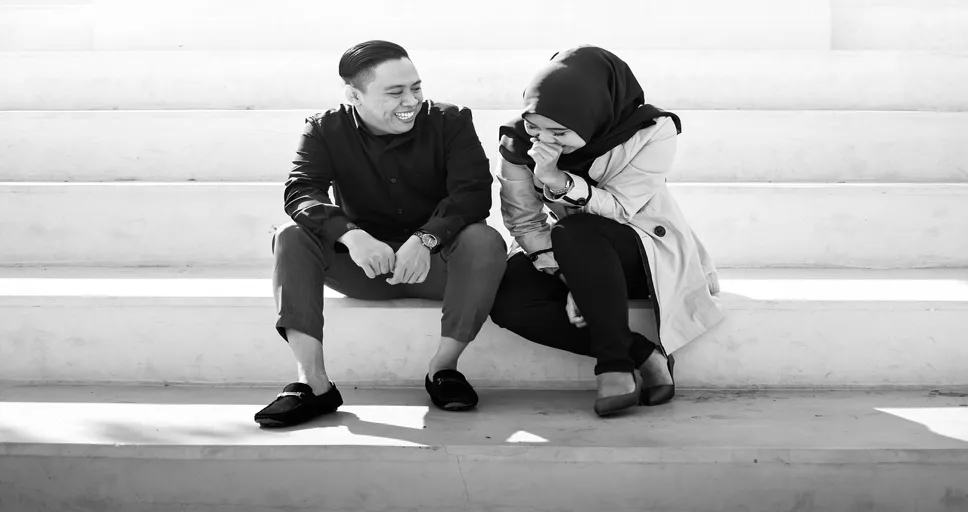Contents
- 1 Stares At Me But Acts Uninterested: Reasons Why He Might Do That?
- 2 Body Language: Interpreting Non-Verbal Cues
- 3 Mixed Messages: What Could Be Going On?
- 4 The Role of Social Dynamics
- 5 Self-Reflection: Understanding Your Own Feelings
- 6 Approaching the Situation: Do’s and Don’ts
- 7 Building Healthy Communication
- 7.1 Start with Self-Communication
- 7.2 Choose the Right Time and Place
- 7.3 Use “I” Statements
- 7.4 Listen Actively
- 7.5 Acknowledge Their Feelings
- 7.6 Avoid Assumptions and Judgments
- 7.7 Express Your Needs and Boundaries
- 7.8 Practice Patience and Understanding
- 7.9 Follow-Up Conversations
- 7.10 Seek External Support if Necessary
- 8 Frequently Asked Questions
- 8.1 When you catch a guy staring at you and he doesn’t look away?
- 8.2 Why does he stare at me but not approach?
- 8.3 When you catch a guy staring at you and then he looks away?
- 8.4 Why does he stare at me but ignores me?
- 8.5 Why do guys stare at me but never talk to me?
- 8.6 Why does he stare but doesn’t approach?
- 8.7 Why do people stare and not look away?
- 8.8 Why is he staring at me but not talking to me?
- 8.9 What does it mean when a guy stares at you but doesn’t say anything?
- 8.10 What does it mean when you catch someone staring at you and they look away?
- 8.11 Why do men stare at me and then look away?
- 9 Navigating Complex Interpersonal Dynamics
- 9.1 Recognize the Complexity
- 9.2 Analyze the Relationship Dynamics
- 9.3 Consider the Context
- 9.4 Reflect on Communication Patterns
- 9.5 Empathize with Their Perspective
- 9.6 Self-awareness and Emotional Intelligence
- 9.7 Managing Expectations
- 9.8 Respect Boundaries
- 9.9 Seek Support if Needed
- 9.10 Patience and Flexibility
- 10 Recommended Authors For Further Reading
When someone stares at you but acts uninterested, it’s like a puzzle waiting to be solved. Decoding this behavior can reveal a lot about the person’s intentions and feelings. The act of staring often signifies a high level of interest or curiosity. However, the seemingly uninterested demeanor that accompanies it adds a layer of complexity to the situation.
Understanding the Incongruity
The incongruity between staring and acting uninterested can stem from various reasons. For some, it’s a protective mechanism, a way to hide their true feelings due to shyness, fear of rejection, or uncertainty about their own emotions. In these cases, the staring is involuntary – a natural response to attraction or interest – while the aloof behavior is a conscious effort to maintain a facade of disinterest.
Context Matters
The context in which this behavior occurs is critical. In a professional setting, for example, the stares might be admiring but the person may act uninterested due to the formal environment. In social settings, peer pressure or existing relationships could influence someone to mask their interest.
Analyzing Frequency and Duration
Pay attention to the frequency and duration of the stares. Frequent, prolonged staring usually indicates a stronger interest compared to fleeting glances. This pattern, combined with an apparent lack of interest, could suggest that the person is deeply intrigued but hesitant to initiate direct communication.
Understanding these signals is the first step in unraveling the mystery of someone who stares at you but seems uninterested. It requires patience and a keen sense of observation to interpret these mixed signals correctly.
- Deciphering Stares with Uninterested Behavior: Understand that staring often indicates interest or curiosity, while acting uninterested may be a protective mechanism, influenced by shyness, fear of rejection, or uncertainty.
- Contextual Factors: Consider the setting (professional, social) as it influences behavior.
- Observing Frequency and Duration: Frequent and prolonged staring suggests stronger interest than brief glances.
- Fear of Rejection: Staring from a distance can be a way to avoid vulnerability.
- Social and Cultural Influences: Norms may dictate subtle expressions of interest.
- Communication Difficulties: Staring can be an easier, non-verbal form of communication for some.
- Thrill of the Chase: The ambiguity and mystery might be appealing to some individuals.
- Personal Insecurities: The person may feel unworthy or doubtful of reciprocated feelings.
- Unconscious Behavior: Staring might be unintentional, without romantic or personal interest.
- Interpreting Body Language: Eye contact, facial expressions, posture, gestures, proximity, and mirroring behavior can give clues to true feelings.
- Cross-Referencing Cues: Compare verbal interactions with non-verbal behavior for inconsistencies.
Stares At Me But Acts Uninterested: Reasons Why He Might Do That?
When someone stares at you but acts uninterested, it can be perplexing and challenging to understand their true intentions. This behavior, often seen as a complex signal, can have various underlying reasons.
Fear of Rejection
One of the primary reasons someone might engage in this behavior is the fear of rejection. Staring from a distance allows them to express their interest without the risk of a direct confrontation. By acting uninterested, they protect themselves from the vulnerability that comes with openly showing their feelings. This behavior is especially common in individuals who have faced rejection or humiliation in the past.
Social and Cultural Norms
Social and cultural norms can also play a significant role. In many cultures, direct expression of interest, especially in a romantic context, is frowned upon. Therefore, a person might resort to staring as a subtle way to show interest, while the display of disinterest could be a compliance with societal expectations. In such scenarios, the individual is caught between the desire to express their feelings and the need to adhere to cultural norms.
The Challenge of Communication
Communication challenges are another factor. Some people struggle with verbalizing their emotions and feelings. For them, staring is an easier and less confrontational form of communication. However, they might act uninterested as a defense mechanism, especially if they are not confident in their communication skills or are unsure of how to navigate the situation further.
The Thrill of the Chase
In some cases, the reason behind this behavior could be the thrill of the chase. For these individuals, the excitement lies in the ambiguity and the game of cat and mouse. They might enjoy the attention and curiosity their behavior evokes without the intention of taking things further. This can be particularly confusing for the person on the receiving end of such mixed signals.
Personal Insecurities
Personal insecurities can also lead to this contradictory behavior. A person might stare because they are genuinely interested, but their insecurities about themselves – be it their appearance, social status, or personality – could prevent them from engaging more openly. They might feel unworthy of attention or doubt that their feelings would be reciprocated.
Unconscious Behavior
Sometimes, the act of staring might be an unconscious behavior that the person is not fully aware of. They might find you visually appealing or interesting in a non-romantic way, leading to their stares. However, their disinterest could genuinely reflect their lack of romantic or personal interest.
Understanding the reason behind why someone stares at you but acts uninterested requires careful consideration of the context, the individual’s personality, and the nature of your relationship with them. It is a delicate balance of interpreting non-verbal cues and understanding the psychological underpinnings of human behavior. While it can be frustrating to deal with such mixed signals, approaching the situation with empathy and open-mindedness can often provide clarity.
Body Language: Interpreting Non-Verbal Cues
Interpreting non-verbal cues is crucial in understanding the perplexing situation where someone stares at you but acts uninterested. Body language often reveals more than words, offering insights into a person’s true feelings and intentions. By observing and interpreting these subtle signals, you can gain a clearer understanding of the confusing behavior.
Eye Contact and Gaze
The eyes are particularly expressive in non-verbal communication. If someone frequently stares at you, it typically signifies a strong interest or attraction. However, the nature of this interest can vary. Prolonged eye contact might indicate romantic interest, while a fleeting or averted gaze could suggest admiration or curiosity with no intent of deeper engagement.
Facial Expressions
Facial expressions can provide clues to the emotions behind the stares. A soft, lingering stare with a gentle smile may imply affection, whereas a neutral or cold expression could indicate a mere intrigue or even unintentional staring. Pay attention to micro-expressions – brief, involuntary facial expressions that reveal true emotions. They might be fleeting, but they’re often more honest than controlled expressions.
Posture and Orientation
Observe the person’s posture and body orientation when they’re around you. People often subconsciously orient their bodies towards someone they’re interested in. If the individual’s body is consistently turned towards you, even when they act disinterested, it could be a sign of hidden attraction. Conversely, if their body is often turned away or closed off, the interest might not be as strong.
Gestures and Movements
Gestures can also be revealing. Nervous gestures, like fidgeting or touching the neck, might indicate a concealed interest or anxiety about expressing it. On the other hand, confident, open gestures could suggest a comfort level that contradicts their apparent disinterest.
Proximity and Personal Space
The physical distance maintained can be telling. Someone who is interested might close the distance, finding excuses to be near you. However, if they maintain a strict personal space boundary or even increase distance after staring, it might reflect a conflict between their interest and their willingness or ability to engage further.
Mirroring Behavior
Mirroring, where a person subconsciously imitates your body language, can indicate rapport and interest. If the person who stares at you but acts uninterested mirrors your movements or posture, it might be a sign that they are more attuned to you than they let on.
Cross-referencing Verbal and Non-Verbal Cues
Finally, it’s important to cross-reference these non-verbal cues with any verbal interactions you have. Inconsistencies between what they say and how they act can be particularly revealing. For instance, if they engage in light, friendly conversation but their body language is closed off or distant, it might indicate a dissonance between their social politeness and their personal feelings.
In summary, when someone stares at you but acts uninterested, their body language can provide valuable clues to their true feelings. By carefully observing and interpreting these non-verbal cues, you can navigate this confusing situation with greater understanding and insight. Remember, however, that body language is complex and can be influenced by a variety of factors, so consider the broader context and the individual’s unique personality and circumstances when interpreting these signals.
Mixed Messages: What Could Be Going On?

Dealing with mixed messages, especially when someone stares at you but acts uninterested, can be confusing and emotionally taxing. This behavior often leaves you guessing about their true feelings and intentions. Understanding what could be going on requires delving into the psychology behind mixed messages and the circumstances that might lead to such behavior.
The Psychology of Mixed Messages
Mixed messages often stem from internal conflicts within the person exhibiting this behavior. They might be battling between their feelings of attraction and their fear of expressing these feelings. This can be due to various reasons such as past experiences, personal insecurities, or the fear of rejection. When someone stares at you, it might be an unconscious display of their interest. However, their actions might not align with this interest due to these internal conflicts, resulting in them acting uninterested.
Situational Factors
The context in which these mixed messages occur is crucial. In certain environments, like a workplace, someone might feel compelled to hide their personal feelings to maintain professionalism. In social settings, peer pressure or the presence of others might influence their behavior, making them act more reserved or indifferent than they actually feel.
Communication Styles
Differences in communication styles can also lead to mixed messages. Some people are not adept at expressing their feelings verbally and might resort to non-verbal cues like staring to convey their interest. Their apparent disinterest could be a result of their inability to communicate their feelings effectively or their choice of a passive communication style.
The Role of External Influences
External influences such as cultural norms, societal expectations, or advice from friends and family can also contribute to someone sending mixed messages. They might be influenced by conventional beliefs about how they should behave or feel pressured to act in a certain way that doesn’t align with their true feelings.
Fear of Vulnerability
Another factor is the fear of vulnerability. Exposing one’s feelings can be daunting, and the risk of emotional exposure might lead someone to mask their true feelings. This is particularly true in cases where the person is unsure about how their feelings will be received. They might stare as an involuntary response to their attraction but act uninterested as a defense mechanism to protect themselves from potential emotional exposure or hurt.
The Impact of Past Experiences
Past experiences, especially negative ones, can have a significant impact on how a person behaves in similar situations. If someone has been hurt in the past, they might be hesitant to show their interest openly for fear of repeating history. This hesitation can manifest as mixed messages, where they stare at you but act uninterested as a protective measure.
In conclusion, when someone stares at you but acts uninterested, there are often complex reasons behind this behavior. It could be a result of psychological conflicts, communication styles, external influences, or past experiences. Understanding the potential reasons can help in interpreting their behavior and deciding how to respond. It’s important to approach such situations with empathy and patience, keeping in mind that mixed messages often reflect deeper emotional or psychological challenges.
The Role of Social Dynamics
Understanding the social dynamics at play is essential when deciphering why someone stares at you but acts uninterested. Social dynamics refer to the behavioral patterns, roles, and interactions within a social context, which can significantly influence individual behavior. In this scenario, various factors within these dynamics can contribute to the perplexing behavior of staring while displaying disinterest.
Peer Influence and Social Norms
One of the most influential aspects of social dynamics is the impact of peers and prevailing social norms. The individual’s behavior might be heavily influenced by the expectations or the perceived judgment of their social circle. For instance, if their friends or social group value a certain type of demeanor or view openly showing interest as inappropriate, this could lead the person to mask their true feelings, resulting in them staring but acting uninterested.
Contextual Behavior
The context in which the staring occurs can also shed light on this behavior. In certain settings, like a professional environment or during social gatherings, people are more conscious of their behavior and how it is perceived by others. This consciousness can lead to self-regulation of their actions, prompting them to act in a way that conforms to the social norms of that setting, even if it conflicts with their inner feelings.
The Impact of Social Roles
Social roles and the expectations associated with them can also play a significant role. For example, if the individual holds a position of authority or is perceived to have a certain image to maintain, they might feel compelled to act in a manner that aligns with these roles. This can lead to a situation where someone stares at you but acts uninterested due to the conflict between their social role and their personal feelings.
Cultural Factors
Cultural background and upbringing greatly influence how individuals express or conceal their emotions. In some cultures, direct expression of interest, especially in a romantic context, is discouraged, which might lead to mixed signals. A person from such a background might stare as a subtle indication of interest but remain outwardly uninterested due to cultural conditioning.
The Influence of Group Dynamics
Group dynamics, such as the presence and behavior of others in the immediate social environment, can also affect individual behavior. If the person is around friends or colleagues who may have opinions about their interest in you, they might act uninterested to avoid gossip or judgment, even though their stares might suggest otherwise.
Social Anxiety and Personal Insecurities
Social anxiety and personal insecurities can be amplified by social dynamics. The individual might be genuinely interested but fears how they might be perceived by others or worries about the implications of their interest being known. This can lead to them sending mixed signals – staring due to their interest but acting uninterested due to their anxiety or insecurities.
In summary, the role of social dynamics in a situation where someone stares at you but acts uninterested is multifaceted. It encompasses the influence of peer and cultural norms, contextual behavior, social roles, group dynamics, and personal insecurities. Recognizing these factors can provide a more nuanced understanding of the individual’s behavior and help in navigating this complex situation. Remember, each case is unique, and it’s important to consider the broader social context and the individual’s background when interpreting such behaviors.
Self-Reflection: Understanding Your Own Feelings

When confronted with a situation where someone stares at you but acts uninterested, it’s not just about interpreting their behavior; it’s also crucial to understand and reflect on your own feelings. Self-reflection in this context involves examining your emotional responses, expectations, and perceptions to gain clarity about what you truly feel and want from this situation.
Identifying Your Emotional Response
Start by identifying how this behavior makes you feel. Do you feel intrigued, flattered, confused, or perhaps frustrated? Understanding your emotional response is the first step in unraveling your feelings towards the situation. For instance, if you find yourself constantly thinking about why this person stares at you but seems uninterested, it might indicate a deeper interest or concern on your part.
Analyzing Your Attraction and Interest
Examine the nature of your attraction or interest in this person. Is it purely based on curiosity provoked by their mixed signals, or do you find other qualities in them that draw you in? Sometimes, the intrigue of mixed messages like someone who stares at you but acts uninterested can heighten your interest in them, but it’s important to discern whether this interest is superficial or has a deeper connection.
Considering Your Expectations
Reflect on what you expect or hope for in this situation. Are you looking for a romantic relationship, a friendship, or simply clarity about their behavior? Understanding your expectations can help guide your actions and decisions regarding how to approach or respond to this person.
Assessing the Impact on Your Well-being
Consider how this situation affects your emotional well-being. If it’s causing significant stress or distraction, it’s important to address these feelings. Your emotional health should be a priority, and understanding whether this situation contributes positively or negatively to your life is crucial.
Exploring Your Confidence and Self-esteem
Your reaction to this situation can also reflect aspects of your self-esteem and confidence. Do you feel empowered to seek clarity, or do you find yourself hesitant and insecure? Sometimes, such scenarios can be an opportunity for personal growth, helping you to build confidence in handling complex interpersonal dynamics.
Understanding the Role of Past Experiences
Your past experiences in relationships and interactions can influence your interpretation of and reaction to the current situation. For instance, if you have a history of misinterpreting signals or have been in a similar situation before, this might affect how you perceive someone who stares at you but acts uninterested.
Seeking Clarity within Yourself
Ultimately, the most important aspect of self-reflection in this context is seeking clarity within yourself. Understanding your feelings, expectations, and reactions provides a foundation for how you choose to respond or not respond to this situation. It’s about aligning your actions with what truly resonates with your feelings and values.
In summary, understanding your own feelings when dealing with someone who stares at you but acts uninterested is as important as deciphering their behavior. Through self-reflection, you can gain insights into your emotional responses, expectations, and personal growth. This process not only helps in dealing with the current situation but also in making more informed decisions in your interpersonal relationships. Remember, clarity often begins with understanding oneself.
Approaching the Situation: Do’s and Don’ts
When faced with the puzzling scenario where someone stares at you but acts uninterested, knowing how to approach the situation appropriately is key. It requires a balance of sensitivity, assertiveness, and respect for both your feelings and theirs. Here are some do’s and don’ts to consider in navigating this complex dynamic.
Do’s
Do Assess Your Comfort Level
Before taking any action, gauge your comfort level with the situation. If the person’s behavior makes you uneasy or if you’re not interested in pursuing any form of relationship, it may be best to maintain a polite distance.
Do Consider a Direct Approach
If you’re comfortable and curious, consider addressing the situation directly. A straightforward conversation can provide clarity. Phrase your observations kindly and openly, perhaps saying something like, “I’ve noticed you often seem to look my way, but I’m not sure what that means. Can we talk about it?”
Do Reflect on Their Possible Perspectives
Keep in mind that the person might be unaware of the mixed signals they’re sending. They might be surprised to learn that their behavior is being interpreted as them staring at you but acting uninterested.
Do Maintain Respect and Empathy
Regardless of the outcome, approach the situation with respect and empathy. Recognize that they might be dealing with personal issues or feelings that are causing this behavior.
Do Set Boundaries if Needed
If their behavior continues and you feel uncomfortable, it’s important to set clear boundaries. Politely but firmly communicate your feelings and the need for personal space.
Don’ts
Don’t Jump to Conclusions
Avoid making assumptions about their reasons for behaving this way. There could be numerous explanations for why someone stares at you but acts uninterested, and it’s not always about attraction.
Don’t Gossip or Speculate with Others
Discussing the situation with mutual friends or colleagues can lead to gossip and could complicate the situation further. Keep your observations and actions discreet.
Don’t Ignore Your Own Feelings
While trying to understand their behavior, don’t neglect your own feelings and comfort. If the situation is causing distress or confusion, it’s important to address it.
Don’t Confront Them Aggressively
If you choose to bring up the subject, avoid confrontational or accusatory language. This can lead to defensiveness and discomfort, hindering any chance of a sincere conversation.
Don’t Let It Affect Your Self-Esteem
Remember, their behavior is about them, not you. Don’t let this situation negatively impact your self-esteem or self-worth.
In conclusion, dealing with someone who stares at you but acts uninterested can be challenging. Approaching the situation with a balance of directness, empathy, and self-respect is crucial. Whether you decide to address it directly or choose to let it go, ensure that your actions align with your comfort and values. Remember, communication and boundaries are key in navigating such complex interpersonal dynamics.
Building Healthy Communication

In situations where someone stares at you but acts uninterested, building healthy communication is key to resolving the ambiguity. Communication is not just about talking; it’s about understanding, respecting boundaries, and expressing oneself clearly. This is crucial in navigating the complex emotions and signals involved in such situations.
Start with Self-Communication
Before addressing the other person, it’s important to communicate with yourself. Understand your feelings about the situation. Are you interested in knowing why they behave this way? Are you looking for a friendship, a relationship, or just clarity? Answering these questions will help guide your approach.
Choose the Right Time and Place
If you decide to address the issue, choose an appropriate time and place. It should be a setting where both of you feel comfortable and private enough to discuss personal matters without interruptions or external pressures.
Use “I” Statements
When initiating the conversation, use “I” statements to express your feelings. This approach is non-confrontational and focuses on your perceptions. For example, “I’ve noticed that sometimes you stare at me, but I also feel like you’re not interested. This makes me feel a bit confused, and I wanted to talk about it.”
Listen Actively
Active listening is a vital part of healthy communication. Give them space to express their thoughts and feelings. Pay attention not just to their words, but also to their non-verbal cues. This shows respect and openness to understanding their perspective.
Acknowledge Their Feelings
Recognize and acknowledge their feelings, even if they differ from yours. They might be struggling with personal issues or feelings that cause them to send mixed signals. Understanding and empathy can go a long way in resolving misunderstandings.
Avoid Assumptions and Judgments
Jumping to conclusions about why they stare at you but act uninterested can lead to misinterpretations. Keep an open mind and avoid judging their reasons without fully understanding their perspective.
Express Your Needs and Boundaries
Communicate your own needs and boundaries clearly. If their behavior makes you uncomfortable, or if you require certain actions from them, convey this respectfully. It’s important that both parties understand and respect each other’s boundaries.
Practice Patience and Understanding
Misunderstandings are common in complex emotional situations. Patience and understanding are crucial. It might take time for the other person to open up or for both of you to reach a mutual understanding.
Follow-Up Conversations
One conversation may not be enough to fully resolve the situation. Be open to having follow-up conversations. This ongoing dialogue can strengthen understanding and improve the dynamics of your relationship or interaction.
Seek External Support if Necessary
Sometimes, external support like advice from a trusted friend, mentor, or counselor can provide additional perspectives and help in building healthy communication strategies.
In summary, when faced with a situation where someone stares at you but acts uninterested, building healthy communication is essential. It involves self-awareness, choosing the right context, expressing yourself clearly, active listening, and patience. Through effective communication, you can navigate this complex situation with greater understanding and hopefully reach a resolution that is comfortable for both parties.
- Staring with an uninterested demeanor may indicate hidden feelings, shyness, or fear of rejection.
- Context, such as professional or social settings, influences this behavior.
- Frequent and prolonged staring suggests deeper interest despite a facade of disinterest.
- Reasons include fear of rejection, social norms, communication challenges, thrill of the chase, personal insecurities, or unconscious behavior.
- Interpreting non-verbal cues like eye contact, facial expressions, posture, gestures, proximity, and mirroring behavior helps understand true intentions.
- Cross-referencing verbal and non-verbal cues can reveal inconsistencies and provide clarity.
Frequently Asked Questions
When you catch a guy staring at you and he doesn’t look away?
It might indicate interest or curiosity, as maintaining eye contact often suggests confidence and an attempt to gauge your reaction.
Why does he stare at me but not approach?
This could be due to shyness, uncertainty about how you might respond, or he’s simply admiring you from afar without the intention of initiating contact.
When you catch a guy staring at you and then he looks away?
Looking away after being caught staring could be a sign of shyness, embarrassment, or an attempt to be polite and not make you feel uncomfortable.
Why does he stare at me but ignores me?
This could indicate conflicting feelings or uncertainty on how to interact, or he may be admiring you from a distance without the intent to engage directly.
Why do guys stare at me but never talk to me?
This may happen if they are shy, unsure of how to initiate conversation, or are simply admiring you without the desire for further interaction.
Why does he stare but doesn’t approach?
He might be hesitant due to shyness, fear of rejection, or is content with just observing without the intention of making a connection.
Why do people stare and not look away?
People might stare and not look away due to deep thought, distraction, or being captivated by something about you, sometimes without realizing their own behavior.
Why is he staring at me but not talking to me?
He could be shy, unsure how to start a conversation, or simply enjoys observing you without the intention of engaging in dialogue.
What does it mean when a guy stares at you but doesn’t say anything?
This can suggest interest or curiosity, but a hesitancy to communicate could stem from shyness, uncertainty, or a non-confrontational nature.
What does it mean when you catch someone staring at you and they look away?
It often means they are either shy, embarrassed, or trying to be respectful by not making you feel uncomfortable with prolonged staring.
Why do men stare at me and then look away?
This behavior could be due to shyness, an attempt to be discreet, or a fleeting moment of admiration without the intent of any further interaction.

Navigating the complex interpersonal dynamics when someone stares at you but acts uninterested can be a challenging yet enlightening experience. Interpersonal dynamics are the patterns of interaction and behavior between individuals, influenced by their emotions, motivations, and social contexts. Understanding and effectively navigating these dynamics is crucial in resolving the ambiguity and achieving a comfortable resolution for both parties.
Recognize the Complexity
Firstly, acknowledge that human behavior is complex and multifaceted. When someone stares at you but seems uninterested, it’s often a reflection of a mix of emotions, thoughts, and social factors that are not immediately apparent. Recognizing this complexity helps in approaching the situation with an open mind.
Analyze the Relationship Dynamics
Consider the nature of your relationship with this person. Are they a colleague, friend, acquaintance, or a stranger? Understanding the existing relationship dynamics can provide clues about their behavior. For example, if they are a colleague, professional boundaries might be influencing their actions.
Consider the Context
The context in which the staring occurs can offer significant insights. Social settings, cultural backgrounds, and the presence of others can all impact how individuals behave. For instance, in a group setting, peer pressure or social norms might influence their behavior.
Reflect on Communication Patterns
Assess the communication patterns between the two of you. Have there been opportunities for open and honest communication? Misunderstandings and mixed messages are often a result of inadequate communication. Identifying gaps or barriers in communication can help in finding ways to address them.
Empathize with Their Perspective
Try to empathize with their perspective. They might be dealing with personal issues, insecurities, or confusion about their own feelings. Understanding that their behavior is not necessarily about you, but about their internal struggles, can aid in navigating the situation more empathetically.
Self-awareness and Emotional Intelligence
Utilize self-awareness and emotional intelligence. Understand your feelings, reactions, and how they influence your interactions. This awareness can guide you in responding to their behavior in a balanced and thoughtful manner.
Managing Expectations
Manage your expectations regarding the outcome of any interaction. While you might seek clarity or a specific response, they might not be ready or able to provide that. Being realistic about what to expect can prevent disappointment and misunderstandings.
Respect Boundaries
Always respect personal boundaries, both yours and theirs. If their behavior makes you uncomfortable, it’s important to communicate this respectfully and set clear boundaries.
Seek Support if Needed
In navigating complex interpersonal dynamics, it’s sometimes helpful to seek external support. This could be in the form of advice from friends, mentors, or professional counselors who can provide an outside perspective.
Patience and Flexibility
Finally, exercise patience and flexibility. Resolving complex interpersonal dynamics often takes time and may require a flexible approach as the situation evolves.
In summary, navigating the complex interpersonal dynamics when someone stares at you but acts uninterested requires a multifaceted approach. It involves recognizing the complexity of human behavior, analyzing the relationship and context, empathizing with the other person, utilizing emotional intelligence, managing expectations, respecting boundaries, and being patient and flexible. Through a thoughtful and empathetic approach, it’s possible to navigate these dynamics effectively, leading to improved understanding and potentially a resolution of the ambiguity.
Recommended Authors For Further Reading
- Deborah Tannen – Tannen is a renowned linguist and author who specializes in how language use impacts relationships. Her works provide insights into understanding indirect communication and mixed signals in interpersonal dynamics.
- John Gray – Gray is best known for his work on gender differences in communication. His insights can help in deciphering the puzzling behaviors often exhibited in male-female interactions.
- Susan Page – A relationship expert, Page’s writings delve into understanding and navigating complex romantic dynamics, which can be useful in understanding seemingly contradictory behaviors.
- Esther Perel – Perel is a prominent psychotherapist whose work focuses on human relationships and intimacy. Her insights are valuable in understanding the subtleties of romantic interest and interaction.
- Leil Lowndes – An expert in communication, Lowndes offers practical advice on understanding and interpreting body language and non-verbal cues in relationships, which can be crucial in deciphering mixed signals.


